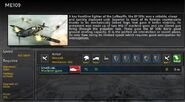A key front line fighter of the Luftwaffe, the Messerschmitt Bf 109C (in-game: ME109) was a reliable, cheap and quickly deployed unit. Superior to most of its foreign counterparts thanks to its mechanically linked flaps that gave better stability, its armament was made up of two MG-17 machine-guns and one 20mm gun firing the propeller hub. These gave the Bf 109c fairly good ground strafing capacity. It is the perfect air interdiction or escort plane, its only flaw is limited speed which requires good anticipation for interceptions. The ME109 can be upgraded to the better jet fighter ME262.
The ME 109 was the Luftwaffe (literally, "air weapon(s)") 's main fighter throughout the war. It was limited to a 20 minute flight over Britain during the air campaign there due to the lack of fuel necessary to fly longer. Though this problem was fixed, the ME 109 was eventually outclassed by American Mustangs and other Allied fighters.
As the Luftwaffe was losing air superiority, the Bf 109 was rebuilt into Jagd-Bomber (fighter-bomber) models, that could have two more guns (that could be 30 mm cannons, same as the Me 262), or bombs for dive attacks, to replace the vulnerable Stuka.
History[]

The Messerschmitt Bf 109 is one of the few fighters ever to be developed from a light-plane design. Willy Messerschmitt's angular little fighter was built in greater numbers than any other fighter plane, the total reaching 33,000.
The Messerschmitt Bf 109 also shot down more Allied planes than any other aircraft, and stayed in service longer than most, having entered combat in the Spanish Civil War (1936-39), fighting through World War II, and then going to war again in 1947, this time for the newly emerging state of Israel.
The great success and longevity of the Messerschmitt Bf 109 can be attributed to the simple directness of its design. In 1934, Messerschmitt engineers sought to place the biggest possible engine in the smallest possible airframe, and make that airframe easy to produce and repair. They succeeded admirably on all counts. The first flight, in September 1935, was made with an imported Rolls-Royce Kestrel engine of 695 horsepower.
Successive design changes to the Messerschmitt Bf 109 led to an increasingly streamlined aircraft. The one seen here is a Bf 109F, which appeared not long after the 1940 Battle of Britain.
Over the years, more than 100 variants of the basic design were created, including modifications introduced on Spanish and Czech production lines after the war. Larger and larger engines were installed, along with hundreds of pounds of additional equipment, and the tough little airframe took it. Examples from the final German operational version, the Bf 109K series, had a 2,000-horsepower engine and a top speed of 450 miles per hour -- not bad for a design begun in 1934.
Throughout its career, the Bf 109 was pitted against new and powerful adversaries, notably upgraded British Spitfires and the North American P-51 Mustang. In the hands of a capable pilot, the "Me 109" as it was most often called, inevitably held its own. Tricky to take off and land, and not the best gun platform, the Messerschmitt nevertheless remained a formidable adversary until the last day of the war.
Strategy[]
Pros & Cons[]
This section is a stub, so be patient and expand it.
Weapons[]
| Weapon | ||||||||||
|---|---|---|---|---|---|---|---|---|---|---|
Small cal. Machine-guns |
75 | 75 | 31 | 0m |
Gallery[]
See also[]
| ||||||||||||||||||||||||||

